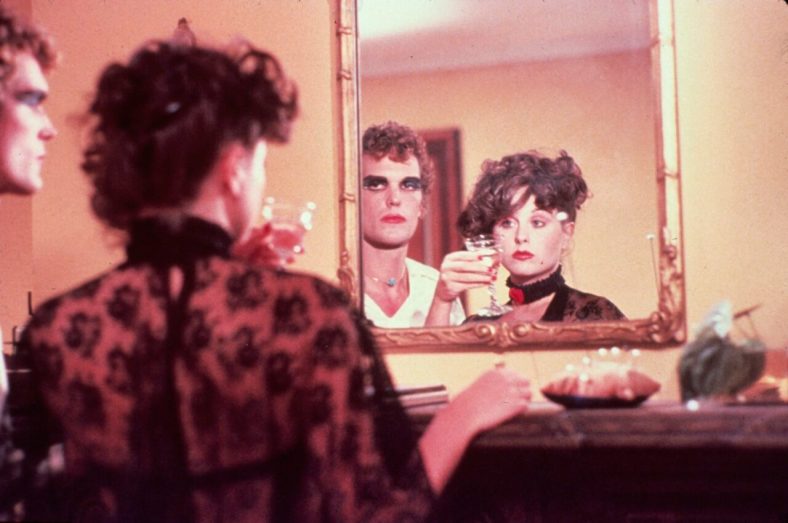‘Savage Weekend’ And The Unapologetically Queer Nicky [The Lone Queer]

We’re here. We’re queer. And we’re going to take some deep dives into The Lone Queer characters present in horror films past. In the past, obvious queer representation has been scarce. Coding and baiting were prevalent, but there are some characters who have stood out as solid queer individuals. Most of those end up dead and buried by the film’s end thus giving birth to the phrase, “Bury your queers.” So let’s resurrect and appreciate those who were buried, appreciate those who survived, and those who were just a little bit naughty. Let’s give the respect that is deserved for The Lone Queer.
There were a few proto-slashers that came before John Carpenter’s 1978’s Halloween catapulted the subgenre to new frights. How many of those slashers included a queer character, though? Even throughout the 80s, queer inclusion was scarce, if at all. That’s where David Paulsen’s 1979 film Savage Weekend comes into play. Although released in 1979 after the success of Halloween, Savage Weekend was filmed in 1976 under the title The Killer Behind the Mask. Technically predating Halloween, it included—as the original title tells—a killer who wore a mask and stalked a group of friends who were getting away from city life.
Amongst that group of friends is our lone queer, Nicky (Christopher Allport). The previous The Lone Queer spoke on the portrayal of a lesbian of the 70s in Someone’s Watching Me!. With Savage Weekend, we get a portrayal of a white gay man. I don’t know why it baffles me that both Sophie and Nicky were handled so nonchalantly, but it does. This is the 70s that we’re talking about. Sure, it was pre-AIDS epidemic, and this is during the time of free love, but the representation of queer people in the media was usually on the side of the villain.
Nicky is anything but the villain. He’s the best friend of the main character, Marie (Marilyn Hamlin). Marie is a single mother living in the city, and Nicky helps her out with her kid. The introduction of all of the characters shows Nicky filling in as the fatherly role. Nicky, himself, is single, and lives—what I assume—the single, gay life, yet finds time to come in for his bestie, and help her out. Normal bestie shit. And that’s how I like to see my queers portrayed in horror or any form of media. Normal. Side note: I like to see them kick ass, as well. Nicky does just that in a scene specifically garnered for him.
What made me fall in love with Nicky is this scene. Imagine, a little hick bar that the group stops in on their way to their cabin. Nicky walks in with an attitude that he owns the place, but respects it. He walks in as a person who is comfortable with himself. He knowingly flirts with the bartender, then settles in for his drink. A convo charged with sexual innuendo about the shape of the moon being perfect for fishing occurs between Nicky and an elderly yet naive bar patron.
Two other patrons, seemingly straight but looking like two gay pornstars from the 70s, begin making crude comments to Nicky. They comment on his short shorts, and make advances that are obviously homophobic. Nicky won’t have it. After making a comment about the size of the patrons’ dicks, Nicky escalates things before they can. He takes both of the bar patrons on in a queer versus the straights bar fight. And who comes out on top (no pun intended, maybe)? Nicky.
From there on, sadly, Nicky becomes your regular slasher character. Making quips here and there along with Marie’s sister, Shirley (Caitlyn O’Heaney), and strangely watching straight couples have sex. I say strangely because there’s one scene in which Shirley and a dude are getting it on, and while Nicky watches, he grasps onto the barbed part of a barbed wire fence, drawing blood. There are many roads that can be traveled on what this means. I like to see it as a physical manifestation of a sexually frustrated individual, but also as a metaphor for the desire to see the act of sex or love for queer people on screen. If heteronormative canoodling can be done on screen, why not queer canoodling?
The pinnacle of Nicky’s inclusion within Savage Weekend occurs right before the film buries him (that’s 3 out of 3 lone queers that have been buried). After a dinner party with the group, Shirley and Nicky engage in a cabin-wide tango set to the best generic 70s tango music. Shirley, the most sex-positive character in the movie, removes her dress to reveal an ensemble of lingerie. She’s living her sex-positive fantasy. Nicky has makeup applied (lipstick and some killer eyeshadow), living his best queer fantasy. They tango dance/chase each other around the cabin. Then our slasher, masked up, joins the tango, silently stalking them in sync with the music.
There’s no possible way to describe how perfectly this is accomplished. As a proto-slasher, it sets up exactly what will be seen in slashers to come. The sex-positive woman and the queer character feel and appreciate their sexuality only to end up on the sharp end of the slasher’s chosen weapon. Their deaths come at the pinnacle of them really feeling themselves. Nicky is looking in the mirror, perfecting his eyeshadow, when the slasher stabs him in the temple with a large sewing pin.
That’s the end for Nicky. It’s such a shame that Nicky isn’t spoken about more within the queer-sphere of horror. He’s a great friend. He’s true to himself. He doesn’t back down when homophobia comes his way. Nicky is a leader in the horror queer-sphere. Granted, he may not be mentioned much due to Savage Weekend not being an entirely well-known film. It deserves to be known, and Nicky deserves to be known as well.
Categorized:Editorials News

